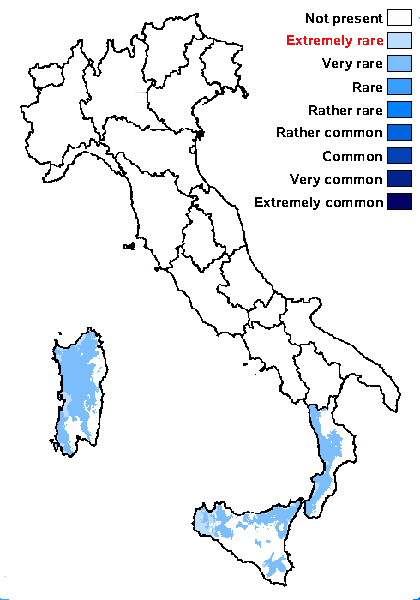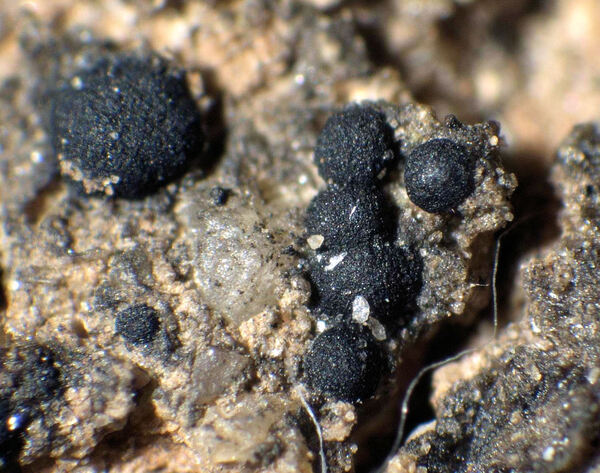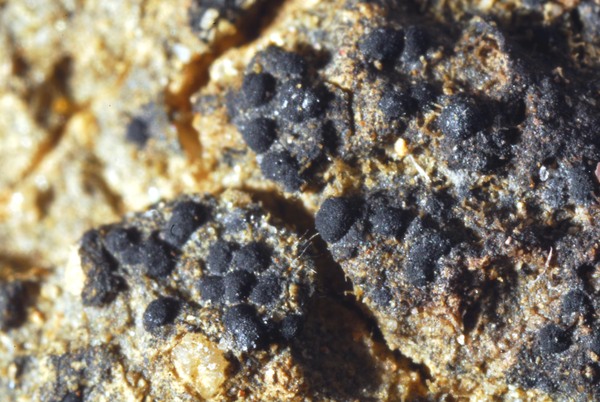Micarea melaenida (Nyl.) Coppins
Bull. Brit. Mus. Nat. Hist., Bot. ser., 11: 154, 1983. Basionym: Lecidea melaenida Nyl. - Flora, 48: 146, 1865.
Synonyms: Catillaria melaenida (Nyl.) Arnold; Catillaria schumannii Körb. ex Stein; Catillaria schumannii var. meridionalis Cl. Roux & Vězda; Catillaria zsakii Szatala; Toninia zsakii (Szatala) Lettau
Distribution: C - Sar (Zedda & al. 2010, Cogoni & al. 2011). S - Cal (Puntillo 1996, Puntillo & Puntillo 2004), Si (Ottonello & al. 2011).
Description: Thallus crustose effuse, greenish white, c. 40-100 μm thick, film-like or of confluent, convex, 0.1-0.6 mm wide areoles. Apothecia micareoid, numerous, scattered or confluent in clusters of 2-4, convex to hemispherical, dull black, 0.2-0.6(-1.2) mm across, without a distinct proper margin (the marginal zone sometimes with a radiating, white, arachnoid tomentum). Proper exciple poorly developed, best evident in young apothecia, purple brown, of radiating, branched and anastomosing hyphae; epithecium scarcely differentiated from the hymenium; hymenium purple brown in upper part, pale purple in lower part, K- and N+ purple red; paraphyses numerous, branched and anastomosing in upper part, 1-1.7 µm thick, the apical cells up to 2.5 µm wide; hypothecium mottled dark purplish brown, 60-120(-200) µm high, N+ purple-red. Asci 8-spored, clavate, with a I+ blue tholus and an internal, darker I+ tubular structure. Ascospores 0-1-septate, hyaline, ellipsoid to oblong-ovoid, straight or slightly curved, (7-)9.5-15 x 3-4.5 µm. Pycnidia frequent, black, immersed, 0.05-0.1 mm across, the wall purple brown, K-. Conidia more or less cylindrical, 4.8-7 x c. 1 µm. Photobiont micareoid, the cells 4-7 μm wide. Spot tests: thallus K-, C-, KC-, P-, UV-. Chemistry: thallus without lichen substances.Note: a mainly mild-temperate species, with optimum on clay soil in rather disturbed habitats below the subalpine belt.
Growth form: Crustose
Substrata: soil, terricolous mosses, and plant debris
Photobiont: green algae other than Trentepohlia
Reproductive strategy: mainly sexual
Pioneer species
Commonnes-rarity: (info)
Alpine belt: absent
Subalpine belt: absent
Oromediterranean belt: absent
Montane belt: very rare
Submediterranean belt: absent
Padanian area: absent
Humid submediterranean belt: very rare
Humid mediterranean belt: extremely rare
Dry mediterranean belt: absent

Predictive model
Herbarium samples
Growth form: Crustose
Substrata: soil, terricolous mosses, and plant debris
Photobiont: green algae other than Trentepohlia
Reproductive strategy: mainly sexual
Pioneer species
Commonnes-rarity: (info)
Alpine belt: absent
Subalpine belt: absent
Oromediterranean belt: absent
Montane belt: very rare
Submediterranean belt: absent
Padanian area: absent
Humid submediterranean belt: very rare
Humid mediterranean belt: extremely rare
Dry mediterranean belt: absent

Predictive model
| Herbarium samples |
 INDEX FUNGORUM
INDEX FUNGORUM
 GBIF
GBIF




